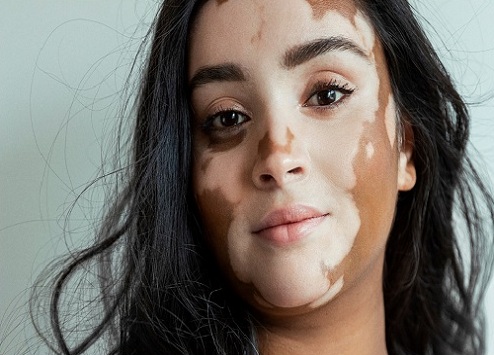
Patients suffering from Vitiligo are also found to experience the following:
• Social and psychological stress
• Sunburn and skin Cancer
• Eye problems like inflammation of the iris
• Hearing loss
Signs and Symptoms
• Patchy loss of skin colour
• Premature greying of the hair present on the scalp, eyelashes, eyebrows or beard.
• The mucous membrane lining tissues inside the mouse and nose lose their colour.
• Retina, the inner layer of the eyeball, also loses their colour.
Types of Vitiligo
The classification of the different types of Vitiligo is done based on the location of the presence of discolouration on the body. The different types are:
• Generalized Vitiligo: is a common type of vitiligo, which affects many parts of the body. It progresses symmetrically on the corresponding body parts.
• Segmental Vitiligo: is a type that usually appears either on one side or a part of the body. It occurs at a young age, progress for a couple of years and then disappears.
• Localized or Focal Vitiligo: is a type that usually occurs in one or a few areas of the body.
The doctor might confirm the diagnosis by opting for the following:
• Taking a biopsy or a small sample of the skin affected by the discolouration.
• Conduct blood tests to check for autoimmune conditions.
VITILIGO TREATMENT
Vitiligo can be treated using different treatment options, as listed below, depending on the skin’s type, extent and other conditions.
• Medications
Using some drugs alone or in combination with other therapies can restore some of the skin tones. The doctors might recommend:
o Anti-Inflammatory creams on the affected skin might help return the skin colour if used early. These changes might even take months to be noticed.
o Medications affecting immune systems: have been found to be effective in people with small patches, usually on the neck and face.
• Therapy
Some of the therapies recommended by doctors are:
o Combination of Light Therapy & Psoralen: can help the skin colour to return to light patches. This will include the application of psoralen, which is followed by shining of UV light on the affected area. This might be repeated 3 times a week for 6-12 months
o Depigmentation: is usually opted in cases of widespread vitiligo. The unaffected skin is first applied with a depigmenting agent and then lightened to blend with the discoloured area. This is done 1 or 2 times daily for more than 9 months.
• Surgery
The doctor might opt for surgery if the therapies and medications don’t work. Some of the surgical procedures opted for are:
o Skin Grafting is when the doctor removes small segments of the normal, pigmented skin and attaches them to the affected areas that lost their pigmentation. o Blister Grafting is when the doctor will create blisters on the pigmented skin using suction and then remove the tops of the blisters and transplant them to the affected area.
o Melanocyte transfer
o Tattooing / Micropigmentation is when the doctor implants the skin’s pigment using a special surgical instrument. This is a more effective method for areas in and around the lips, particularly for patients with a darker complexion
The classification of the different types of Vitiligo is done based on the location of the presence of discolouration on the body. The different types are:
• Generalized Vitiligo: is a common type of vitiligo, which affects many parts of the body. It progresses symmetrically on the corresponding body parts.
• Segmental Vitiligo: is a type that usually appears either on one side or a part of the body. It occurs at a young age, progress for a couple of years and then disappears.
• Localized or Focal Vitiligo: is a type that usually occurs in one or a few areas of the body.
The doctor might confirm the diagnosis by opting for the following:
• Taking a biopsy or a small sample of the skin affected by the discolouration.
• Conduct blood tests to check for autoimmune conditions.
VITILIGO TREATMENT
Vitiligo can be treated using different treatment options, as listed below, depending on the skin’s type, extent and other conditions.
• Medications
Using some drugs alone or in combination with other therapies can restore some of the skin tones. The doctors might recommend:
o Anti-Inflammatory creams on the affected skin might help return the skin colour if used early. These changes might even take months to be noticed.
o Medications affecting immune systems: have been found to be effective in people with small patches, usually on the neck and face.
• Therapy
Some of the therapies recommended by doctors are:
o Combination of Light Therapy & Psoralen: can help the skin colour to return to light patches. This will include the application of psoralen, which is followed by shining of UV light on the affected area. This might be repeated 3 times a week for 6-12 months
o Depigmentation: is usually opted in cases of widespread vitiligo. The unaffected skin is first applied with a depigmenting agent and then lightened to blend with the discoloured area. This is done 1 or 2 times daily for more than 9 months.
• Surgery
The doctor might opt for surgery if the therapies and medications don’t work. Some of the surgical procedures opted for are:
o Skin Grafting is when the doctor removes small segments of the normal, pigmented skin and attaches them to the affected areas that lost their pigmentation. o Blister Grafting is when the doctor will create blisters on the pigmented skin using suction and then remove the tops of the blisters and transplant them to the affected area.
o Melanocyte transfer
o Tattooing / Micropigmentation is when the doctor implants the skin’s pigment using a special surgical instrument. This is a more effective method for areas in and around the lips, particularly for patients with a darker complexion
© theskincentresirsa.com, All Right Reserved.
Designed By Camsol India